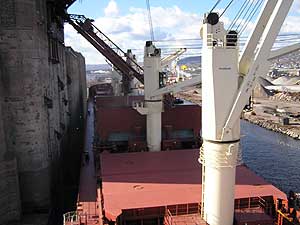|
Audio
Photos
More from MPR
Resources
Your Voice
|
Little Ships on the Big Lakes
November 5, 2004
 |
| The Bluebill is tucked up beside Duluth's AGP Grain Elevator, taking on a load of soybeans and wheat. This is the view from a deck just outside the ship's bridge. (MPR Photo/Bob Kelleher) |
Duluth, Minn. — Most people know the Duluth port for shipping iron ore. But a third of the port's tonnage is in agricultural products - like soybeans, wheat, and other grains.
So Duluth Port officials says it's particularly encouraging to see the Bluebill in dock. It's a new ship - built small - with a small crew - and packed with the latest electronic wizardry.
Polish Captain Cezary Luczywek says the Bluebill is designed to just squeeze through the Seaway's narrow locks and under draw bridges. He points to what are called the wings on the bridge - the parts that stick out a bit to give the captain a better view.
 | |||
"As you notice the wings are at the angles," Luczywek says. "They are not straight ones. Because the bridges in the Welland Canal are not straight up, only a little bit at the angle."
Even so, it's a tight fit. The Bluebill's new green paint is already scraped to bare metal in places. At 78 feet wide, the ship passes the Seaway locks' concrete walls with just a foot to spare. She's made to take the occasional bump. Small by ocean standards, the ship is still more than two football fields long - and her gleaming white bridge rises some seven stories above the water.
Luczywek captains a crews of 18 - about half the number you'd find on an older ship of this size. Some of the smaller ships have crews of a dozen or less. The Bluebill's engine room is fully automated. Most of the time there's no one there. To a large degree, the ship is run by computers.
"Computerized, fully automation," Luczywek says. "I have everything on the bridge. I have the control on the bridge - engine control. (It) is very easy to handle, for me as a captain, you know. (It) is quite convenient. Quite easy."
The Bluebill was built for Montreal-based Canformav - a company that's put 13 new ships into the Great Lakes trade in four years. Errol Francis is Canfornav's Vice President of Operations. Francis says most companies had stopped building ships for the lakes. Bigger vessels were more profitable. And Great Lakes locks take their toll. Francis says that banging into lock walls can take 10 years off a ship's life.
"So we recognized that if we wanted to make a commitment to the lakes, or keep our commitments to the Great Lakes and trading, we'd have to build our own ships." Francis says. "So (we) get other partners involved in joint ventures to build ships (so)that we could trade the lakes - which has been traditionally our bread and butter."
 | |||
The new ships are a welcome sight for Duluth Port officials. They mean ongoing life for the St. Lawrence Seaway, which just turned 45 years old. Duluth Port Director Adolph Ojard concedes the Seaway is narrow and shallow by today's standards.
"That has always been an issue for the Great Lakes, due to our limitations in the locks, at 740 feet," Ojard says. "So, as we see new owners investing in new ships, that confirms that we certainly have a future on the Great Lakes in serving the international scene."
Problems can be opportunities. Overseas customers don't necessarily have deep ports either. And that's the beauty of the Bluebill and her sister ships. They can haul directly from Duluth to many customer's docks.
"These ships coming into the port and going directly to these shallow draft markets provide a very efficient and effective method of servicing the customers, and it cuts out some of the middle mans and distributions necessary for larger ships," Ojard says.
It's a renewed niche market - little ships for little ports. And a promise there will be an ongoing parade of vessels for future Duluth ship watchers.
|
News Headlines
|
Related Subjects
|
